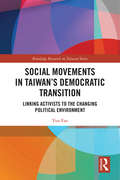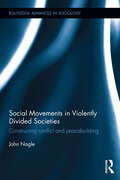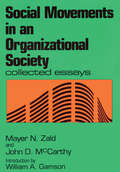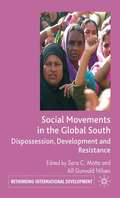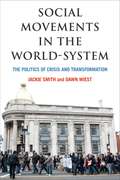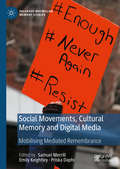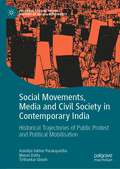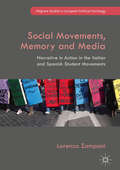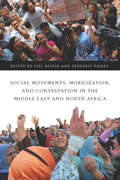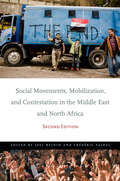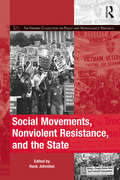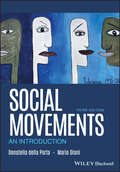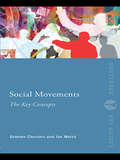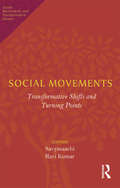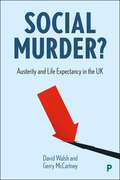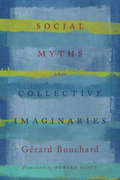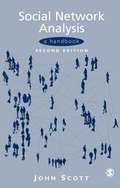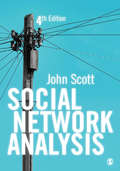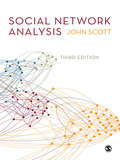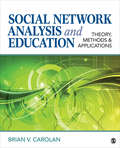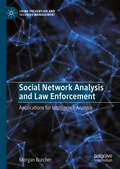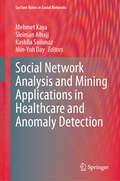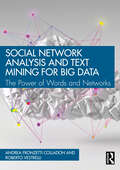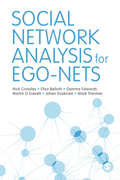- Table View
- List View
Social Movements in Taiwan’s Democratic Transition: Linking Activists to the Changing Political Environment (Routledge Research on Taiwan Series)
by Yun FanExamining the relationships between activists and the changing political environment, this book analyzes the trajectories of three major social movements in Taiwan during the country’s democratic transition between 1980 and 2000. In doing so, it explores why the labor and environmental movements became less partisan, while the women’s movement became more so. Providing a comparative discussion of these critical social movements, this book explores key theoretical questions and presents a rich and comprehensive analysis of social activism during this period of Taiwan’s political history. It focuses on causal mechanisms and variation and thus avoids the tautological trap of finding an "improving" political opportunity structure wherever a social movement is flourishing. Drawing on extensive data from over 140 activists’ demographic backgrounds, the discussion also builds upon existing studies of the "biographical" aspects of contention. This study then asks further questions about how certain tactics are chosen, not only how a repertoire of contention comes to have the shape it does. Combining both a theoretical and an empirical approach, this book will be useful to students and scholars of Taiwanese politics and society, as well as social movements and democracy more generally.
Social Movements in Violently Divided Societies: Constructing Conflict and Peacebuilding (Routledge Advances in Sociology)
by John NagleViolently divided societies present major challenges to institutions seeking to establish peace in places characterised by ethnic conflict and high levels of social segregation. Yet such societies also contain groups that refuse to be confined within separate forms of ethnic community and instead develop alternative modes of action that generate shared identities, build trust and foster consensual, peaceful politics. Advancing a unique social movement approach to the study of violently divided societies, this book highlights how various social movements function within a context of violent ethnic politics and provide new ways of imagining citizenship that complements peacebuilding. By analysing the impact of social movements on divided societies, this book contributes to debates about the complexity of belonging and identity, and constructs a nuanced understanding of political mobilisation in regions defined by ethnic violence. In turn, the book provides important insights into the dynamics of social movement mobilisation. Based on the author's extensive research in Lebanon and Northern Ireland, and drawing on numerous examples from other divided societies, this book examines a range of social movements, including nationalists, victims, sexual minorities, labour movements, feminists, environmentalists, secularists, and peace movements. Bringing together social theory and case studies in order to consider how grassroots movements intersect with political institutions, this book will be of interest to students, scholars and policymakers working in sociology and politics.
Social Movements in an Organizational Society: Collected Essays
by Mayer N. Zald John D. McCarthyFirst Published in 2017. Routledge is an imprint of Taylor & Francis, an Informa company.
Social Movements in the Global South
by Alf Gunvald Nilsen Sara C. MottaPopular struggles in the global south suggest the need for the development of new and politically enabling categories of analysis, and new ways of understanding contemporary social movements. This book shows how social movements in Africa, South Asia, Latin America, and the Middle East politicize development in an age of neoliberal hegemony.
Social Movements in the World-System: The Politics of Crisis and Transformation
by Jackie Smith Dawn Wiest American Sociological Association StaffGlobal crises such as rising economic inequality, volatile financial markets, and devastating climate change illustrate the defects of a global economic order controlled largely by transnational corporations, wealthy states, and other elites. As the impacts of such crises have intensified, they have generated a new wave of protests extending from the countries of the Middle East and North Africa throughout Europe, North America, and elsewhere. This new surge of resistance builds upon a long history of transnational activism as it extends and develops new tactics for pro-democracy movements acting simultaneously around the world. In Social Movements in the World-System, Jackie Smith and Dawn Wiest build upon theories of social movements, global institutions, and the political economy of the world-system to uncover how institutions define the opportunities and constraints on social movements, which in turn introduce ideas and models of action that help transform social activism as well as the system itself. Smith and Wiest trace modern social movements to the founding of the United Nations, as well as struggles for decolonization and the rise of national independence movements, showing how these movements have shifted the context in which states and other global actors compete and interact. The book shows how transnational activism since the end of the Cold War, including United Nations global conferences and more recently at World Trade Organization meetings, has shaped the ways groups organize. Global summits and UN conferences have traditionally provided focal points for activists working across borders on a diverse array of issues. By engaging in these international arenas, movements have altered discourses to emphasize norms of human rights and ecological sustainability over territorial sovereignty. Over time, however, activists have developed deeper and more expansive networks and new spaces for activism. This growing pool of transnational activists and organizations democratizes the process of organizing, enables activists to build on previous experiences and share knowledge, and facilitates local actions in support of global change agendas. As the world faces profound financial and ecological crises, and as the United States dominance in the world political economy is increasingly challenged, it is especially urgent that scholars, policy analysts, and citizens understand how institutions shape social behavior and the distribution of power. Social Movements in the World-System helps illuminate the contentious and complex interactions between social movements and global institutions and contributes to the search for paths towards a more equitable, sustainable, and democratic world. "
Social Movements, Cultural Memory and Digital Media: Mobilising Mediated Remembrance (Palgrave Macmillan Memory Studies)
by Emily Keightley Priska Daphi Samuel MerrillThis collected volume is the first to study the interface between contemporary social movements, cultural memory and digital media. Establishing the digital memory work practices of social movements as an important area of research, it reveals how activists use digital media to lay claim to, circulate and curate cultural memories. Interdisciplinary in scope, its contributors address mobilizations of mediated remembrance in the USA, Germany, Sweden, Italy, India, Argentina, the UK and Russia.
Social Movements, Media and Civil Society in Contemporary India: Historical Trajectories of Public Protest and Political Mobilisation (Palgrave Studies in the History of Social Movements)
by Anindya Sekhar Purakayastha Manas Dutta Tirthankar GhoshThis book examines instances of transformative dissent, turning points or shifts in popular mobilisation patterns in contemporary India, while adopting a historical approach and analysing past events. Exploring the different continuities and discontinuities in mobilising patterns and dissident agency in India, the authors present a heterogeneous insurrectional pattern that pivoted around issues of caste, class, religion, land reform, labour, taxation and territorial control, with anti-colonialism movements becoming prominent in the first half of the twentieth century. The authors move beyond this to explore more recent templates of mobilisation which surfaced towards the end of the twentieth century, during India’s liberalisation period. With growing marketisation and technological advancement, unprecedented changes in social relations, growing economic opportunities and cultural transfusion taking place, the country became a ‘New India’ - one which aspired to be a global player in the wider technological public sphere. Tracing the historical trajectories of social movements in India, this book examines recent trends in digitised dissidence and explores new frontiers of protests, providing fresh insights for those researching the history of social movements, South Asian and Indian history and postcolonial studies.
Social Movements, Memory and Media: Narrative In Action (Palgrave Studies In European Political Sociology Series)
by Lorenzo ZamponiCultural factors shape the symbolic environment in which contentious politics take place. Among these factors, collective memories are particularly relevant: they can help collective action by providing symbolic material from the past, but at the same time they can constrain people's ability to mobilise by imposing proscriptions and prescriptions. This book analyses the relationship between social movements and collective memories: how do social movements participate in the building of public memory? And how does public memory, and in particular the media’s representation of a contentious past, influence strategic choices in contemporary movements? To answer these questions the book draws its focus on the evolution of the representation of specific events in the Italian and Spanish student movements of the 1960s and 1970s. Furthermore, through qualitative interviews to contemporary student activists in both countries, it investigates the role of past waves of contention in shaping the present through the publicly discussed image of the past.
Social Movements, Mobilization, and Contestation in the Middle East and North Africa
by Joel Beinin Frédéric VairelThe Middle East and North Africa have become places that almost everyone "knows" something about. Too frequently written off as culturally defined by Islam, strongly anti-Western, and uniquely susceptible to irrational political radicalism, authoritarianism, and terrorism-these regions are rarely considered as sites of social and political mobilization. However, this new volume reveals a rich array of mobilizations that neither lead inexorably toward democratization nor degenerate into violence. These case studies of Morocco, Egypt, Lebanon, Saudi Arabia, and Turkey are inspired by social movement theory, but also critique and expand the horizons of the theory's classical concepts of political opportunity structures, collective action frames, mobilization structures, and repertoires of contention through intensive fieldwork. This strong empirical base allows for a nuanced understanding of contexts, culturally conditioned rationality, the strengths and weaknesses of local networks, and innovation in contentious action in a region where, with the exception of Turkey, there was little sign of broad-based movements for democratization until the Tunisian and Egyptian uprisings of 2010-11.
Social Movements, Mobilization, and Contestation in the Middle East and North Africa, Second Edition
by Joel Beinin Frédéric VairelBefore the 2011 uprisings, the Middle East and North Africa were frequently seen as a uniquely undemocratic region with little civic activism. The first edition of this volume, published at the start of the Arab Spring, challenged these views by revealing a region rich with social and political mobilizations. This fully revised second edition extends the earlier explorations of Egypt, Morocco, Lebanon, Saudi Arabia, and Turkey, and adds new case studies on the uprisings in Tunisia, Syria, and Yemen. The case studies are inspired by social movement theory, but they also critique and expand the horizons of the theorys classical concepts of political opportunity structures, collective action frames, mobilization structures, and repertoires of contention based on intensive fieldwork. This strong empirical base allows for a nuanced understanding of contexts, culturally conditioned rationality, the strengths and weaknesses of local networks, and innovation in contentious action to give the reader a substantive understanding of events in the Arab world before and since 2011.
Social Movements, Nonviolent Resistance, and the State (The Mobilization Series on Social Movements, Protest, and Culture)
by Hank JohnstonThis volume probes the intersections between the fields of social movements and nonviolent resistance. Bringing together a range of studies focusing on protest movements around the world, it explores the overlaps and divergences between the two research concentrations, considering the dimensions of nonviolent strategies in repressive states, the means of studying them, and conditions of success of nonviolent resistance in differing state systems. In setting a new research agenda, it will appeal to scholars in sociology and political science who study social movements and nonviolent protest.
Social Movements: An Introduction (Comparative Politics Ser.)
by Donatella della Porta Mario DianiA new, fully-revised and updated edition of the leading introduction to social movements and collective action – covers a broad range of approaches in the social sciences. Now in its third edition, Social Movements is the market-leading introductory text on collective action in contemporary society. The text draws from theory-driven, systematic empirical research from across the social sciences to address central questions and concepts in the field. Sophisticated yet reader-friendly chapters offer critical analyses of relevant literature whilst exploring important issues and debates. The global political landscape has undergone significant changes in the years since this book’s initial publication, such as the spread of online protests, the resurgence of nationalist and right-wing activity, global revolts, and increased social and economic polarization. This thoroughly updated edition offers fresh discussions of recent social movements against austerity from around the world, new empirical examples, references to recent episodes of contention, an expanded comparative approach to social movement theory in the scientific literature, and more. Positioned at the intersection of sociology and political science, this book: Presents an empirical and engaging exploration of contemporary social movements Discusses topics such as organizing within social movements, eventful protests, political opportunities, symbolism and identity in collective action, and social change Highlights how core mechanisms of collective action operate in different movements, past and present Provides a conceptual methodology useful for social science students and researchers alike Highlights how core mechanisms of collective action operate in different movements in the past and present Written by two internationally recognized experts in sociology and political science, the third edition of Social Movements: An Introduction is an essential course text and a must-read for students and scholars of sociology, political sociology, political science, and social movement studies.
Social Movements: The Key Concepts (Routledge Key Guides)
by Graeme Chesters Ian WelshSocial Movements: The Key Concepts provides an insightful, contemporary introduction to some of the frequently encountered terms and groups that are central to the study of collective action and social and political activism. Following an A-Z format, the entries defined and discussed are drawn from the following areas: the ‘old’ social movements of the nineteenth century the ‘new’ social movements of the 1960s and 1970s the rise of contemporary ‘network’ movements. Key American, European and global social movements are addressed, with each entry related to contemporary developments and emergent tendencies within the field. Including helpful references for further study, this concise and up-to-date guide is of relevance for those studying a range of disciplines, including sociology, politics, cultural studies and human geography.
Social Movements: Transformative Shifts and Turning Points (Social Movements and Transformative Dissent)
by Ravi Kumar SavyasaachiThis volume attempts to show the emerging contours of ‘transformative action’ in social movements across South Asia. It argues that these contours have been shaped by contestations over questions of equity, justice and well-being on the one hand, and the nature and scope of new and classical social movements on the other. This is manifest in diverse modes through people’s struggles, protest and dissent. The authors examine a variety of themes that have determined the course of the politics of transformative struggles. They critique neoliberalism, ‘primitive’ accumulation, money, class inequalities, as well as aspects of capital–labour conflict. They highlight the contributions of movements by women, dalit and marginalized communities; peace movements; and environmental and agrarian struggles. The volume also appraises the role of internet in grassroots mobilizations and that of civil society networks in the making of participatory democracy. It further argues that the predicaments of cultural, ethnic, national, regional, and linguistic identities are not divorced from capital–labour conflicts. The book will serve as essential reading for students and scholars of sociology, social movements, politics, gender and feminist studies, labour studies, and the informed general reader.
Social Murder?: Austerity and Life Expectancy in the UK
by David Walsh Gerry McCartneyLife expectancy is about more than just health – it’s about the kind of society we live in. And in the early 2010s, after decades of continual improvement, life expectancy in the UK, US and many other rich countries stopped increasing. For millions of people, it actually declined. Despite hundreds of thousands of extra deaths, governments and officials remained silent. Combining robust evidence with real-life stories, this book demonstrates how austerity policies caused this scandal. It argues that this shocking and tragic suffering was predictable, caused by a dereliction of duty from those in power. The book concludes with an optimistic vision of what can be done to restore life expectancy improvements and reduce health inequalities.
Social Myths and Collective Imaginaries
by Howard Scott Gerard Bouchard Les Editions du BorealMyths are commonly associated with illusions or with deceptive, dangerous discourse, and are often perceived as largely the domain of premodern societies. But even in our post-industrial, technologically driven world, myths – Western or Eastern, ancient or modern, religious or scientific – are in fact powerful, pervasive forces. In Social Myths and Collective Imaginaries, Gérard Bouchard conceptualizes myths as vessels of sacred values that transcend the division between primitive and modern. Myths represent key elements of collective imaginaries, past and present. In all societies there are values and beliefs that hold sway over most of the population. Whether they come from religion, political institutions, or other sources, they enjoy exalted status and go largely unchallenged. These myths have the power to bring societies together as well as pull them apart. Yet the study of myth has been largely neglected by sociologists and other social scientists. Bouchard navigates this uncharted territory by addressing a number of fundamental questions: What is the place of myth in contemporary societies and in the relations between the cultural and the social? How do myths take form? From what do they draw their strength? How do they respond to shifting contexts? Myths matter, Bouchard argues, because of the energy they unleash, energy that enables a population to mobilize and rally around collective goals. At the same time myths work to alleviate collective anxiety and to meet the most pressing challenges facing a society. In this bold analysis, Bouchard challenges common assumptions and awakens us to the transcendent power of myth in our daily lives and in our shared aspirations.
Social Network Analysis
by John ScottThe Third Edition of this best-selling text has been fully revised and updated to include coverage of the many developments on social network analysis over the last decade. Written in a clear and accessible style, the book introduces these topics to newcomers and non-specialists and gives sufficient detail for more advanced users of social network analysis. Throughout the book, key ideas are discussed in relation to the principal software programs available for social network analysis. The book provides a comprehensive overview of the field, outlining both its theoretical basis and its key techniques. Building upon the core ideas of points, lines and paths, John Scott builds a framework of network analysis that covers such measures as density, centrality, clustering, centralization, and spatialization. He identifies the various types of clique, component, and circle into which networks are formed, and he outlines an approach to socially structured positions within networks. A completely new chapter in this edition discusses recent work on network dynamics and methods for studying change over time. A final chapter discusses approaches to network visualisation.
Social Network Analysis
by Professor John ScottIncorporating the most important and cutting-edge developments in the field, this bestselling text introduces newcomers to the key theories and techniques of social network analysis and guides more experienced analysts in their own research. New to This Edition: A chapter on data collection, covering a crucial phase of the research process Fully updated examples reiterate the continued importance of social network analysis in an increasingly interconnected world Detailed ‘Further Reading’ sections help you explore the wider literature Practical exercises including real-world examples of social networks enable you to apply your learning Expanded and brought right up-to-date, this classic text remains the indispensable guide to social network analysis for students, lecturers and researchers throughout the social sciences.
Social Network Analysis
by Professor John ScottIncorporating the most important and cutting-edge developments in the field, this bestselling text introduces newcomers to the key theories and techniques of social network analysis and guides more experienced analysts in their own research. New to This Edition: A chapter on data collection, covering a crucial phase of the research process Fully updated examples reiterate the continued importance of social network analysis in an increasingly interconnected world Detailed ‘Further Reading’ sections help you explore the wider literature Practical exercises including real-world examples of social networks enable you to apply your learning Expanded and brought right up-to-date, this classic text remains the indispensable guide to social network analysis for students, lecturers and researchers throughout the social sciences.
Social Network Analysis (Third Edition)
by John ScottThe Third Edition of this best-selling text has been fully revised and updated to include coverage of the many developments on social network analysis (SNA) over the last decade. Written in a clear and accessible style, the book introduces these topics to newcomers and non-specialists and gives sufficient detail for more advanced users of social network analysis. Throughout the book, key ideas are discussed in relation to the principal software programs available for SNA. The book provides a comprehensive overview of the field, outlining both its theoretical basis and its key techniques. Drawing from the core ideas of points, lines and paths, John Scott builds a framework of network analysis that covers such measures as density, centrality, clustering, centralisation, and spatialisation. He identifies the various types of clique, component, and circle into which networks are formed, and he outlines an approach to socially structured positions within networks. A completely new chapter in this edition discusses recent work on network dynamics and methods for studying change over time. A final chapter discusses approaches to network visualisation. This is an excellent resource for researchers across the social sciences and for students of social theory and research methods.
Social Network Analysis and Education: Theory, Methods & Applications
by Brian V. CarolanSocial Network Analysis and Education: Theory, Methods & Applications provides an introduction to the theories, methods, and applications that constitute the social network perspective. Unlike more general texts, this applied title is designed for those current and aspiring educational researchers learning how to study, conceptualize, and analyze social networks. Brian V. Carolan's main intent is to encourage you to consider the social network perspective in light of your emerging research interests and evaluate how well this perspective illuminates the social complexities surrounding educational phenomena. Relying on diverse examples drawn from the educational research literature, this book makes explicit how the theories and methods associated with social network analysis can be used to better describe and explain the social complexities surrounding varied educational phenomena.
Social Network Analysis and Law Enforcement: Applications for Intelligence Analysis (Crime Prevention and Security Management)
by Morgan BurcherThis book examines the use of social network analysis (SNA) in operational environments from the perspective of those who actually apply it. A rapidly growing body of literature suggests that SNA can reveal significant insights into the overall structure of criminal networks as well as the position of critical actors within such groups. This book draws on the existing SNA and intelligence literature, as well as qualitative interviews with crime intelligence analysts from two Australian state law enforcement agencies to understand its use by law enforcement agencies and the extent to which it can be used in practice. It includes a discussion of the challenges that analysts face when attempting to apply various network analysis techniques to criminal networks. Overall, it advances SNA as an investigative tool, and provides a significant contribution to the field that will be of interest to both researchers and practitioners interested in social network analysis, intelligence analysis and law enforcement.
Social Network Analysis and Mining Applications in Healthcare and Anomaly Detection (Lecture Notes in Social Networks)
by Mehmet Kaya Min-Yuh Day Sleiman Alhajj Kashfia SailunazThis book is an excellent source of knowledge for readers interested in the latest developments in social network analysis and mining, particularly with applications in healthcare and anomaly detection. It covers topics such as sensitivity to noise in features, enhancing fraud detection in financial systems, measuring the echo-chamber phenomenon, detecting comorbidity, and evaluating the effectiveness of mitigative and preventative actions on viral spread in small communities using agent-based stochastic simulations. Additionally, it discusses predicting behavior, measuring and identifying influence, analyzing the impact of COVID-19 on various social aspects, and using UNet for handling various skin conditions. This book helps readers develop their own perspectives on adapting social network concepts to various applications. It also demonstrates how to use various machine learning techniques for tackling challenges in social network analysis and mining.
Social Network Analysis and Text Mining for Big Data: The Power of Words and Networks
by Andrea Fronzetti Colladon Roberto VestrelliSocial Network Analysis and Text Mining for Big Data presents cutting-edge methods and tools that bridge the gap between text mining and social network analysis research while also providing new insights for analyzing (big) textual and network data. These tools are designed to cater to the needs of both business analysts and researchers to facilitate the creation of groundbreaking analytics.Beginning with clear definitions of social network analysis and text mining, this book benefits from a thoughtfully curated selection of methods and tools, drawn from the authors’ extensive research in the field. The focus then shifts to demonstrate how the interplay between words and networks can unlock the full potential of big data analytics. A centerpiece of the book is the Semantic Brand Score (SBS), a versatile and powerful metric for assessing brand importance through text analysis. All of the above is corroborated and illustrated with practical applications and case studies showing the value of these analytics in supporting change and improved managerial decisions. It also introduces a specialized software tool which enables users to perform the analyses detailed in the text.This book is a must-read for business leaders, marketing professionals, policymakers, researchers, and university students. It offers practical insights and actionable advice for achieving increased performance of companies and societal actions. The writing is tailored to make complex concepts accessible to both experienced researchers and readers who are new to the field.
Social Network Analysis for Ego-Nets: Social Network Analysis for Actor-Centred Networks
by Martin G. Everett Nick Crossley Elisa Bellotti Dr Johan Koskinen Dr Gemma Edwards Dr Mark TranmerThe ego-net approach to social network analysis, which takes discrete individual actors and their contacts as its starting point, is one of the most widely used approaches in the field. This is the first textbook to take readers through each stage of ego-net research, from conception, through research design and data gathering to analysis. It starts with the basics, assuming no prior knowledge of social network analysis, but then moves on to introduce cutting edge innovations, covering both new statistical approaches to ego-net analysis and also the most recent thinking on mixing methods (quantitative and qualitative) to achieve depth and rigour. It is an absolute must for anybody wishing to explore the importance of networks.
